
Top 5 Leafy Greens To Grow At Home
Leafy greens are the easiest vegetables to cultivate at home. They're quick to grow, tolerate shade, and provide a harvest even through the winter months. There are a host of varieties out there, from chard and cabbage to salad mixes and kale. Discover the key benefits of leafy greens and five of the best varieties to start out with.
Leafy greens are often viewed as flavourless, boring, and generally unappealing. Below, we’re going to bust this myth wide open. Not only are they delicious when prepared correctly, but they’re super easy to grow at home. Continue reading to become self-sufficient in salad; you’ll never have to buy greens again.
What do we mean by “leafy greens”?
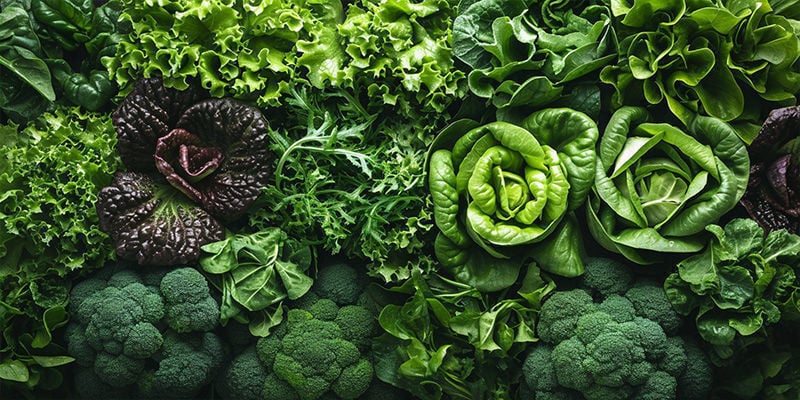
The term leafy greens refers to the leaves of a large group of vegetables that are harvested as food. Whereas some vegetables are grown for their roots, tubers, stems, and even flowers, leafy greens are cultivated specifically for their nourishing foliage. Many common garden vegetables belong to this group, including chard, kale, lettuce, spinach, arugula, and bok choy.
What’s so great about leafy greens?
Leafy greens are often belittled as “rabbit food” food by those who prefer steak over salads. However, when prepared correctly, they’re a delicious addition to a meal and provide a nutritional punch. The top benefits of leafy green vegetables include:
- Packed with vitamins & minerals: Leafy greens are an important part of a healthy diet. They contain many vitamins and minerals that help to keep our systems ticking over, including vitamins A, C, and K, and minerals such as calcium, magnesium, and iron.
- Full of phytochemicals: Micronutrients aside, leafy greens are a great source of antioxidant phytochemicals that help to shield our DNA against damage. Compounds such as carotene and zeaxanthin are also known to support eye health (Johra et al., 2020), whereas sulforaphane can help to tame inflammation (Treasure et al., 2023).
- Versatile in the kitchen: Not all leafy greens are destined for the salad bowl. There are many different ways to incorporate them into tasty dishes, including steaming and sautéing. They’re also a healthy addition to pre- and post-workout smoothies.
Are leafy greens easy to grow?
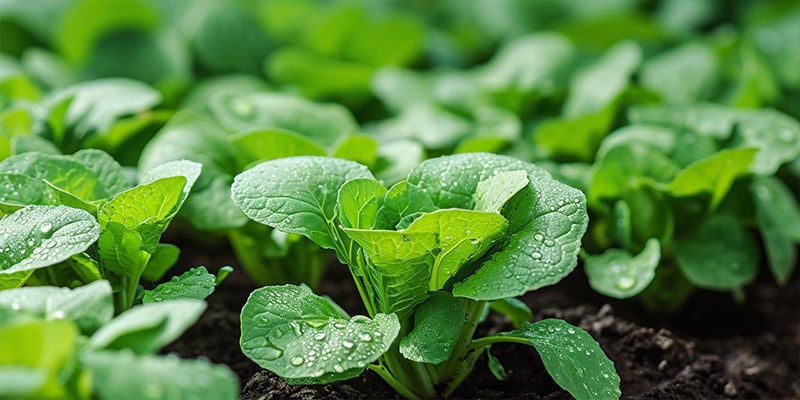
Leafy greens are among the easiest vegetables to grow. In fact, their ease makes them a great entry point into the world of cultivation. There are several traits that make raising leafy greens a breeze, including:
- Speed: Leafy greens become available to harvest quicker than almost any other crop. Unlike squash, cucumbers, and tomatoes, growers don’t need to wait for plants to complete the flowering cycle. Because they are harvested during the vegetative phase, you can start cropping within a matter of weeks from sowing seeds.
- Hardiness: Most leafy greens are exceptionally hardy. Not only will they survive a frost, but exposure to cold temperatures improves their taste by breaking down complex carbs into simple sugars. Leafy greens will grow happily year-round in many climates.
- Shade tolerance: Leafy greens are a good option for shady spots in the garden. You don’t need to fuss too much about where to position them. In fact, they fare much better in more sheltered areas, as excess sun and heat can cause them to run to seed.
- Size: Most leafy greens are small and compact, allowing growers to cultivate enough greens for a small family even with limited space. A single raised bed containing a few rows of kale, spinach, lettuce, and chard will crop constantly over many months.
Common issues when growing leafy greens
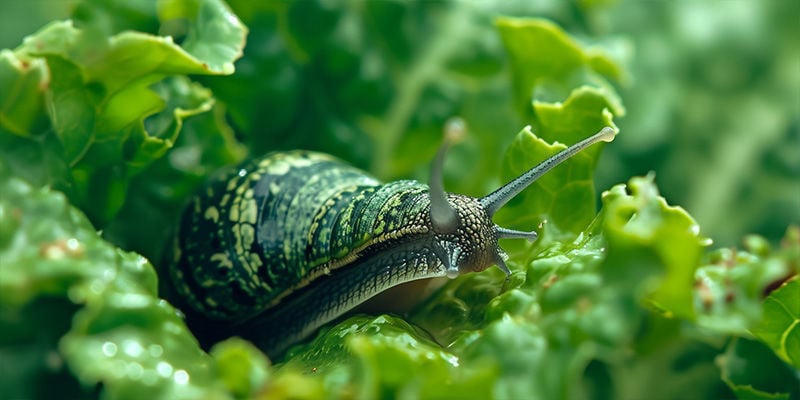
Although they’re one of the easiest categories of plants to grow, you can still run into trouble when growing leafy greens. The most common issues when cultivating them include:
- Slugs: These slimy critters have a ravenous appetite for foliage. Left unchecked, they’ll make quick work of entire plants and leave the remnants covered in goo. Surround the perimeter of your plants with used coffee grounds and organic slug pellets to leave them looking for sustenance elsewhere.
- Caterpillars: Leafy greens that belong to the Brassica family, such as kale, cabbage, and mustard, are firm favourites among caterpillars. Once established, they can demolish an entire plant in a matter of days. Cover these plants with netting to prevent butterflies from laying their eggs on your crops.
- Lack of nitrogen: Leafy greens require a suite of macronutrients and micronutrients to grow correctly. Specifically, nitrogen plays a fundamental role during the vegetative stage by helping to form luscious leaves. A dearth of this element will leave plants looking yellow and stunted. Ensure you start out with fertile soil rich in mature compost or worm castings.
- Bolting: This term describes the phenomenon of leafy greens shooting upwards and developing flowers when exposed to environmental stress. When this happens, their leaves lose flavour and develop a tough texture. Keep your plants safe from excess heat and aim to grow the right varieties at the correct time of year.
Where can they be grown?
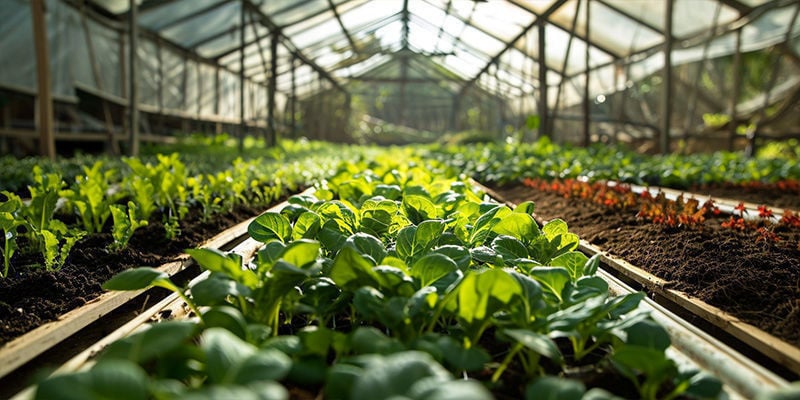
You can grow leafy greens just about anywhere. Outdoors, you need to abide by the ebb and flow of the growing season. Indoors, you can enjoy this nutrient-filled foliage year round. Check out the best places to grow them below:
- Indoors: There are many options when it comes to growing leafy greens indoors. You can raise them in a grow tent in pots or in a hydroponic system. If you’re low on space, consider cultivating them as microgreens on a windowsill.
- Balcony: Leafy greens do well on balconies. Their small size and desire for shade make them compatible with this environment.
- North-facing gardens: Most vegetable plants need plenty of sun, leaving north-facing areas of gardens relatively deserted. Because they thrive in partial shade, you can put these areas to use by growing an assortment of leafy greens.
- Greenhouses: Most leafy greens will quickly bolt when grown in a greenhouse during summer. However, you can use these heat-capturing structures to overwinter leafy greens and procure an ongoing crop throughout winter and early spring.
Top 5 leafy greens to grow at home
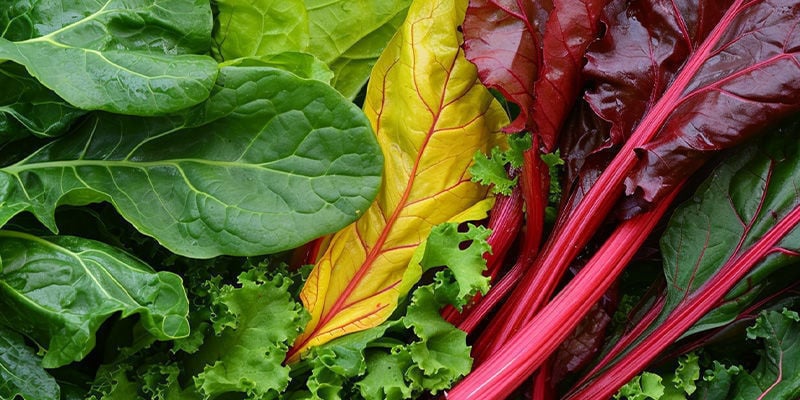
Whether you’re growing leafy greens to become more self-sufficient or to ensure a steady supply of salad for a healthy diet, it's important to familiarise yourself with the different varieties on offer. To ensure the best bang for your buck when it comes to productivity and nutrient density, consider cultivating the five varieties listed below.
Red Swiss chard

Red Swiss chard, known by the Latin binomial Beta vulgaris, puts on quite the show in any garden. The bright red stems and veins contrast wonderfully with the dark green foliage, adding vibrancy to raised beds. But this variety doesn’t just look good; the deep red colouration indicates the presence of antioxidant anthocyanins. While tough when raw, steamed chard makes for a tasty, mineral-rich side dish.
Start chard seeds indoors in module trays in March. Transplant outside when plants reach a height of 5cm and the risk of frost has passed. Space plants 30cm apart and aim to harvest 3–4 leaves from each plant at a time to keep them productive well into the next year.
Mixed French salad
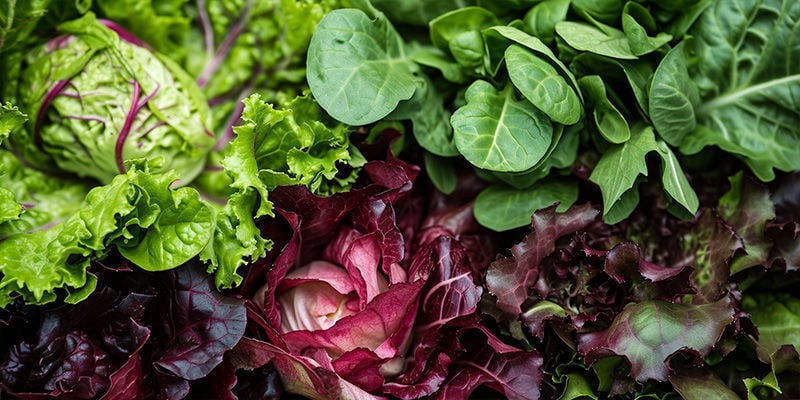
Why settle for growing one variety of leafy green when you can cultivate five at the same time? Our mixed French salad seeds contain red oak leaf lettuce, endive, radicchio, frisée, and arugula, ensuring a mix of beneficial nutrients, phytochemicals, and fibre for your microbiome.
Start out by raking a patch of soil to a fine tilth in early May. Lightly scatter the seeds across a 1m² area, cover with 1cm of sieved compost, and water well. Thin plants to 5cm once they develop their first true leaves. This tight spacing will produce a dense layer of small foliage that you can harvest as baby greens over the next few months.
New Zealand spinach
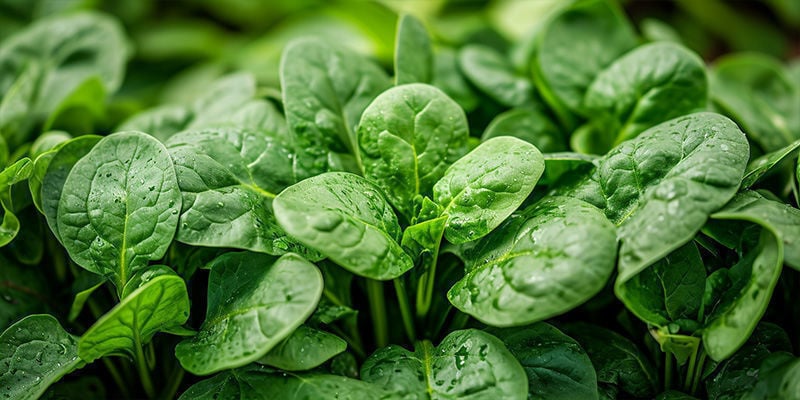
New Zealand spinach, also known as Tetragonia tetragonoides, helps to provide fresh green foliage during the warmer months of the year. While not a true spinach, the leaves of this plant are equally succulent and nourishing. Plus, it grows best during summer, when standard spinach plants bolt and lose their flavour and texture.
Directly sow seeds outdoors when the risk of frost has passed. Sow at a depth of 2cm into a bed enriched with organic matter that receives full or partial sun exposure. Thin plants out to 30cm apart and keep them well-irrigated. Continually harvest leaves from each plant all the way up to November.
Kale

There are many different varieties of kale to choose from, including green, red, purple, curly, and Tuscan. Regardless of the type you choose to grow, you’ll reap the rewards of key vitamins, minerals, and phytochemicals come harvest time. While tough when raw, kale makes for great eating when sautéed or dehydrated into crisps.
Kale helps to keep the garden productive and full during the winter months. Sow seeds in module trays during the start of June and transplant them outdoors with a spacing of 30cm once they develop their first set of true leaves. Place hoops along the bed and cover with butterfly netting. As the first frost approaches, replace the netting with horticultural fleece to keep your plants churning out salad leaves throughout winter and into spring.
Cabbage

Cabbages are packed with vitamin C, vitamin K, fibre, and healthy phytochemicals. While tasty when eaten fresh, many growers choose to process their cabbage into sauerkraut and enjoy this probiotic-rich preserve for many months post-harvest.
Spring, summer, autumn, and winter cabbages all have different sowing and harvesting times. Grow all four types, and you’ll harvest this delicious vegetable all year long. Just make sure to protect your plants with netting during spring and summer, and provide enough space—aim for 45cm between plants—to allow each cabbage to reach its full size.
Try some leafy greens for yourself
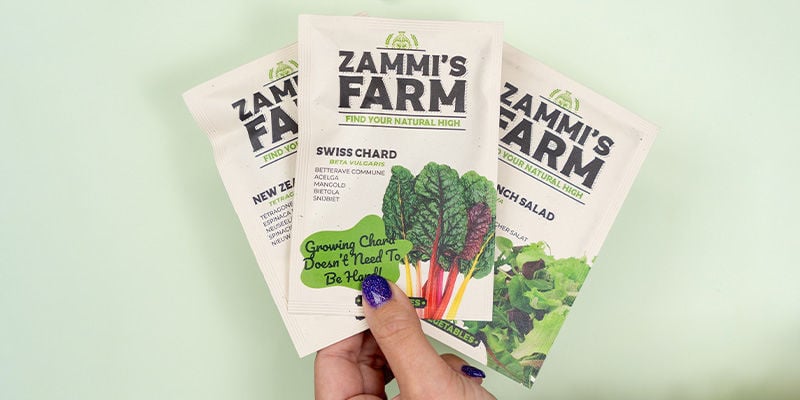
Leafy greens are packed with nutrients and easy to grow. With just a little bit of space and a minimal investment of time, you can supply yourself with fresh salad throughout the year, feel the satisfaction of self-sufficiency, and reap the rewards of a healthy diet. Check the sowing calendar for your region, grab some seeds, and start making plans for a luscious and productive garden!
- Johra, Fatima Tuj, Bepari, Asim Kumar, Bristy, Anika Tabassum, Reza, & Hasan Mahmud. (2020, November). A Mechanistic Review of β-Carotene, Lutein, and Zeaxanthin in Eye Health and Disease - https://doi.org
- Treasure, K., Harris, J., & Williamson, G. (2023). Exploring the anti‐inflammatory activity of sulforaphane - https://doi.org
-
 7 min
8 January 2024
Best Fruits And Vegetables For Cold Climates
So, you live in an area with a short growing season? Your garden freezes over late in spring and early in autumn? While you won't have any luck trying to cultivate tropical, heat-loving plants,...
7 min
8 January 2024
Best Fruits And Vegetables For Cold Climates
So, you live in an area with a short growing season? Your garden freezes over late in spring and early in autumn? While you won't have any luck trying to cultivate tropical, heat-loving plants,...
-
 8 min
28 December 2023
The Best Fruits & Vegetables To Grow In Hot Climates
If you're looking to grow your own fruit and vegetables in a warm climate, you're in the right place! First things first, we'll cover the advantages and drawbacks of warm conditions. Then, you'll...
8 min
28 December 2023
The Best Fruits & Vegetables To Grow In Hot Climates
If you're looking to grow your own fruit and vegetables in a warm climate, you're in the right place! First things first, we'll cover the advantages and drawbacks of warm conditions. Then, you'll...
-
 4 min
19 May 2023
Discover 10 Unique-Looking Vegetables
Do you want to sow some strange and novel fruits and vegetables in your garden this spring? Well, look no further—we’ve got you covered with this top 10 list of odd-looking plants to add some...
4 min
19 May 2023
Discover 10 Unique-Looking Vegetables
Do you want to sow some strange and novel fruits and vegetables in your garden this spring? Well, look no further—we’ve got you covered with this top 10 list of odd-looking plants to add some...
-
 5 min
16 March 2023
Top 10 Easiest Vegetables To Grow
Have you ever considered growing vegetables from home, but thought that your level of expertise or environment was insufficient for the job? Well, here at Zamnesia, we don't believe in such...
5 min
16 March 2023
Top 10 Easiest Vegetables To Grow
Have you ever considered growing vegetables from home, but thought that your level of expertise or environment was insufficient for the job? Well, here at Zamnesia, we don't believe in such...













 United States
United States










